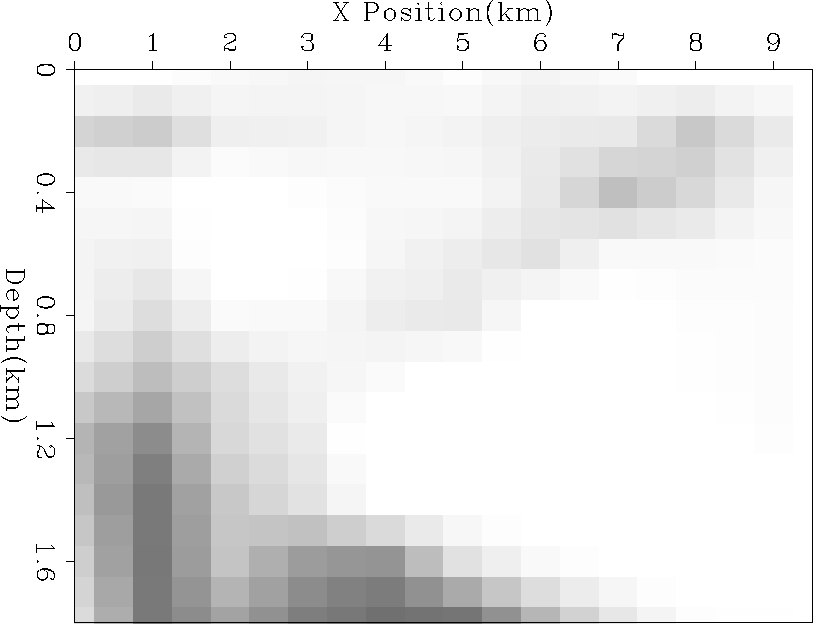




Next: Field tests
Up: Overview of thesis
Previous: Tau tomography
In Chapter ![[*]](http://sepwww.stanford.edu/latex2html/cross_ref_motif.gif) , I introduce a new
way to regularize the tomography estimate
that takes into account the a priori estimate
of geology. I start from a simple missing
data problem.
I compare the conventional way that geophysicists and
geostatisticians characterize covariance and how they
apply to a missing data problem.
I show how non-stationarity makes both solutions suboptimal.
I then introduce another way to approximate model
covariance, a steering filter.
I show that a steering filter can accurately handle a non-stationary
model covariance.
I show how to build a steering filter with as little information
as early migrated reflector positions.
For example, returning to the simply
two layer example (Figure 1), if we
know the dip of the second layer in the model
of Figure 2 we can do a better job constraining
the slowness field using steering filter regularization,
Figure 9.
, I introduce a new
way to regularize the tomography estimate
that takes into account the a priori estimate
of geology. I start from a simple missing
data problem.
I compare the conventional way that geophysicists and
geostatisticians characterize covariance and how they
apply to a missing data problem.
I show how non-stationarity makes both solutions suboptimal.
I then introduce another way to approximate model
covariance, a steering filter.
I show that a steering filter can accurately handle a non-stationary
model covariance.
I show how to build a steering filter with as little information
as early migrated reflector positions.
For example, returning to the simply
two layer example (Figure 1), if we
know the dip of the second layer in the model
of Figure 2 we can do a better job constraining
the slowness field using steering filter regularization,
Figure 9.
reg.tomo
Figure 9 The same tomography
shown in Figure 3 now using steering filters
to regularize the velocity estimate.
|
|  |
![[*]](http://sepwww.stanford.edu/latex2html/movie.gif)





Using the steering filter I develop a new tomography objective function.
I then compare and contrast the results
of using a steering filter to regularize the tomography
problem versus an isotropic regularizer in both depth and tau.
I show that the most reasonable velocity model,
and the best migrated image, comes from using steering filters
in the tau domain.





Next: Field tests
Up: Overview of thesis
Previous: Tau tomography
Stanford Exploration Project
4/29/2001
![[*]](http://sepwww.stanford.edu/latex2html/cross_ref_motif.gif) , I introduce a new
way to regularize the tomography estimate
that takes into account the a priori estimate
of geology. I start from a simple missing
data problem.
I compare the conventional way that geophysicists and
geostatisticians characterize covariance and how they
apply to a missing data problem.
I show how non-stationarity makes both solutions suboptimal.
I then introduce another way to approximate model
covariance, a steering filter.
I show that a steering filter can accurately handle a non-stationary
model covariance.
I show how to build a steering filter with as little information
as early migrated reflector positions.
For example, returning to the simply
two layer example (Figure 1), if we
know the dip of the second layer in the model
of Figure 2 we can do a better job constraining
the slowness field using steering filter regularization,
Figure 9.
, I introduce a new
way to regularize the tomography estimate
that takes into account the a priori estimate
of geology. I start from a simple missing
data problem.
I compare the conventional way that geophysicists and
geostatisticians characterize covariance and how they
apply to a missing data problem.
I show how non-stationarity makes both solutions suboptimal.
I then introduce another way to approximate model
covariance, a steering filter.
I show that a steering filter can accurately handle a non-stationary
model covariance.
I show how to build a steering filter with as little information
as early migrated reflector positions.
For example, returning to the simply
two layer example (Figure 1), if we
know the dip of the second layer in the model
of Figure 2 we can do a better job constraining
the slowness field using steering filter regularization,
Figure 9.

![[*]](http://sepwww.stanford.edu/latex2html/movie.gif)